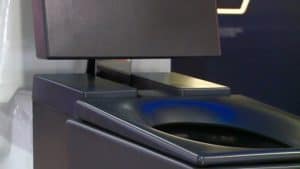
Among the myriad wonders at the world’s biggest electronics expo: robotic maids, flying iPhones, and glasses that allow the blind to see.
But the real symbol of where we’re headed is spinning slowly on a dais: a sleek, black toilet that one might imagine in one of the USS Enterprise’s many bathrooms. The reason Kohler’s Numi toilet will retail for $7,500 US is simple: if your partner forgets to put down the toilet seat, you can simply ask the toilet to do it for you.
This “smart” toilet, which can be commanded to perform certain ablutionary functions and even play music, is a symbol of the hottest thing in the world of technology these days: your voice.
If only a fraction of the new gadgets on display at the CES convention in Las Vegas make it to market, you will soon be able to tell an almost infinite number of things what to do.
“Everything here is voice-activated in some way shape or form, either with an embedded Alexa or Google product in it, or linking up to the Amazon Alexa or the Google Home device,” says Consumer Reports analyst Elliot Weiler.
“Everywhere from the laundry room to the kitchen, even the bathroom. We’ve seen voice-activated mirrors and showers and tubs. And that’s … either in market right now or will be in the market in the next year or two.”
Ben Arnold, a consumer technology analyst with the market research firm NPD Group, says what he’s seeing this year at CES is bringing the world closer to the idea of ambient computing, in which all the electronics around us can sense us and respond to our needs.
“So it’s more than just controlling technology products with your voice. It’s really adding a layer of intelligence and getting technology products to work a little bit better into your life,” Arnold says.
According to one estimate by the global research firm International Data Corporation, by next year one million Canadians will have an intelligent assistant in their homes.
The two biggest players on the market are Amazon and Google, but Arnold says there are plenty of other companies entering the race.
“There’s [Apple’s] Siri, there’s Bixby from Samsung. Facebook just announced products that are connected home products. So there will be many more digital assistants and voice assistance by the end of this year.”
With the battle for smart speaker supremacy heating up, it’s no coincidence this was the first time in years that Google has had a major presence at CES.
At one of Google’s outdoor display booths, Toronto IT specialist Nick Hartmann asks Google Assistant one of dozens of pre-selected questions. He’s impressed by the smart speaker technology he’s seen so far.
“It’s the future,” Hartmann says. “Just … interacting with voice is fantastic.”
But do customers actually need to converse with all of their appliances? According to Weiler, with companies rushing to get on the voice tech bandwagon, in many cases they may be “creating problems that don’t necessarily need to be solved.”
“You can have the voice-activated washer and dryer, but you still have to move the wet clean clothes from the washer to the dryer,” Weiler says. “Why not just push ‘start’ like you can do already? Do you really need to tell Alexa to start your washer?”
Smart home technology provides plenty of cautionary tales. The tech graveyard is littered with smart products no one wanted. Scott Boyarsky, a vice-president at Comcast, says voice control alone isn’t enough.
“These are things like, ‘hey, I just want to be able to automate turning on my lights’ or ‘I just want to be able to turn my thermostat up or down.’ Those are not really delivering on any major value proposition,” Boyarsky says.
The reason many smart products failed, he says, was because they only appealed to early adopters who were willing to put up with instability and complexity.
So in order to increase the mass market appeal of Comcast’s voice-activated Xfinity technology, he says their engineers had to think beyond the old paradigm of having one command for each function, and reduce the customer’s “cognitive load” by providing basic recipes or “scenes.”
“So being able to say right into your voice remote control ‘Xfinity, good morning.’ Your lights go down, your shades go up, your thermostat sets to a certain temperature, your television tunes to your favourite channel, and your coffee pot begins to run.”
In other words, if it doesn’t make what you’re doing better, faster, or cheaper, then it’s just a $7,000 toilet that listens.


